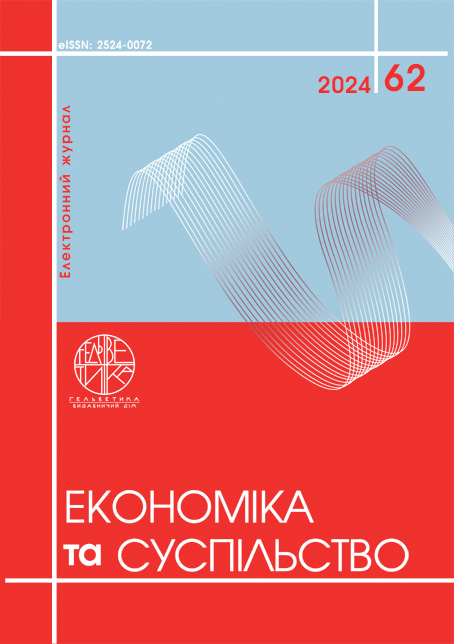BUSINESS CONTINUITY IN UKRAINE: CHALLENGES AND OPPORTUNITIES IN WARTIME
Abstract
The article is devoted to highlighting the current state of Ukraine in the context of vulnerability to current challenges and identifying key tools to minimize threats to business continuity in the context of russian military aggression. The essence of the concept of ‘business resilience’ and its components, including risk management, adaptability and flexibility, and business continuity planning for critical functions, are clarified. The key difference between business resilience and business continuity in terms of the approach to tackling challenges is elucidated. The article identifies four main categories of threats that impede the uninterrupted functioning of Ukrainian enterprises, including anthropogenic (accidental and intentional), technological, biological, and natural disasters. The current state of Ukraine's vulnerability to current threats according to the Fragile States Index and INFORM Risk ratings is analyzed. It has been noted that in 2023, Ukraine was classified as having a ‘high’ risk level. Thus, the author notes a significant deterioration in the level of state stability in the overall Fragile States Index rating in 2023. The key threats to business continuity in Ukraine are identified, including loss of personnel due to dismissal, illness or death, loss of fixed assets or access to them, power outages, disruptions and interference with information technology systems, and disruption of supply chain integrity. Based on the potential threats, the author proposes a list of tools for minimizing them and ensuring continuous business operations in the context of russia's military aggression. It is noted that the specific choice of tools depends on the specifics of the enterprise, its industry, and market conditions. The positive effect of the implementation of the proposed tools for minimizing threats to business continuity on the sustainability and long-term development of Ukrainian enterprises is determined. The author has emphasized that the key factors for the successful implementation and maintenance of an effective business continuity system are a systematic approach, synergy of efforts, and continuous investment.
References
Rouco J. C., Figueiredo P. C. Business Continuity Management and Resilience: Theories, Models, and Processes. IGI Global, 2024. 360 p.
Барський М. В. Безперервність бізнесу в контексті ланцюгів постачання. Сталий розвиток економіки. 2024. № 1(48). С. 302–308. DOI: https://doi.org/10.32782/2308-1988/2024-48-42
Baz J. E., Ruel S. Investigating the role of business continuity during COVID-19: an empirical examination. Supply Chain Forum. 2023. P. 1–14. DOI: 10.1080/16258312.2023.2199127.
Hall T. Business continuity beyond COVID-19: Lessons learned and the ‘illusion of preparedness’. Journal of Business Continuity & Emergency Planning, 2022. Volume 16. Number 1. P. 45–52.
BCI Horizon Scan Report 2023. The Business Continuity Institute (BCI). URL: https://www.thebci.org/resource/bci-horizon-scan-report-2023.html
ISO 22301. Security and resilience − Business continuity management systems − Requirements. URL: https://pttweb7.pttplc.com/pttbcm/upload/media/ 878_ISO22301_2019.pdf
The Global Risks Report 2020. The World Economic Forum. URL: https://www3.weforum.org/docs/WEF_Global_Risk_Report_2020.pdf
Fragile States Index. The Fund for Peace. URL: https://fragilestatesindex.org/
INFORM Risk. European Commission. URL: https://drmkc.jrc.ec.europa.eu/inform-index/INFORM-Risk
Rouco J. C., Figueiredo P. C. Business Continuity Management and Resilience: Theories, Models, and Processes. IGI Global, 2024. 360 p.
Barskyi M. V. (2024) Bezperervnist biznesu v konteksti lantsiuhiv postachannia [Business continuity in the context of supply chain]. Stalyi rozvytok ekonomiky. No 1(48), pp. 302–308. DOI: 10.32782/2308-1988/2024-48-42 (in Ukrainian).
Baz J. E., Ruel S. Investigating the role of business continuity during COVID-19: an empirical examination. Supply Chain Forum. 2023. pp. 1–14. doi: 10.1080/16258312.2023.2199127.
Hall T. Business continuity beyond COVID-19: Lessons learned and the ‘illusion of preparedness’. Journal of Business Continuity & Emergency Planning, 2022. Volume 16. Number 1. pp. 45–52.
BCI Horizon Scan Report 2023. The Business Continuity Institute (BCI). Available at: https://www.thebci.org/resource/bci-horizon-scan-report-2023.html
ISO 22301. Security and resilience − Business continuity management systems − Requirements. Available at: https://pttweb7.pttplc.com/pttbcm/upload/
media/878_ISO22301_2019.pdf
The Global Risks Report 2020. The World Economic Forum. Available at: https://www3.weforum.org/docs/WEF_Global_Risk_Report_2020.pdf
Fragile States Index. The Fund for Peace. Available at: https://fragilestatesindex.org/
INFORM Risk. European Commission. Available at: https://drmkc.jrc.ec.europa.eu/inform-index/INFORM-Risk

This work is licensed under a Creative Commons Attribution 4.0 International License.


